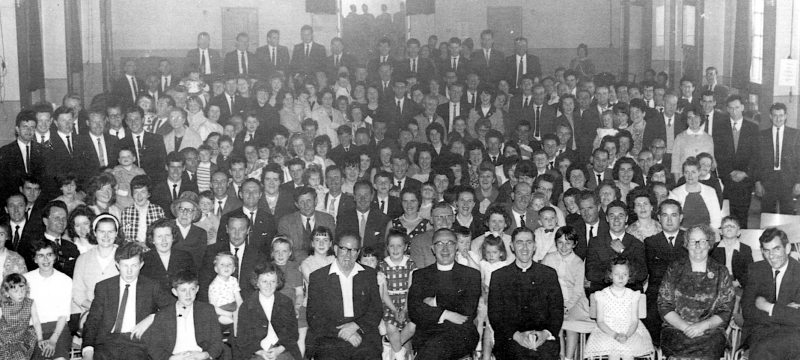Sodalities were very much part of the Catholic faith throughout the 50s. There were usually three every month with the men, women and children having alternative weekends. People went to Confession on Saturday, either at midday or in the evening and then everyone received Communion on Sunday morning. All the seats at the front of the Church were reserved for whichever groups were having the sodality. On sodality day the group would display banners on the edge of the seats to indicate their respective townlands or villages. Each village or townland had a sodality promoter.
The women used to wear special sodality medals on their day. The sodality was a type of regimentation, to facilitate the receiving of Confession and Holy Communion. However, all this was to change after the Second Vatican Council in 1966 when it was decided that it would be better for people to receive the sacraments and attend Mass as a family unit. Consequently the sodality was overtaken by the family but the modern day reality is that this has not really worked in the way that Vatican envisaged it would.
I always enjoyed the Station Masses. They had the potential to bring neighbours together both in the practice of their faith and socially. Bishop Michael Browne wrote a dissertation on the Station Mass for the Vatican. At that time this type of Mass was unique to Ireland. Vatican II embraced the idea completely because it brought the Mass out to the people. They stipulated that it would be known henceforth as the Neighbourhood Mass and envisaged that its appeal would become universal in due course.
I also have very fond memories of all the processions which took place in Tullycross over the years. Many people used to paint their houses specially for the procession, and put up streamers and flower boxes to mark the occasion. I can especially remember the Children of Mary taking part in these processions. They were a group of young women who had taken a simple vow of chastity prior to marriage. They all wore blue capes and sodality medals. At the Corpus Christi procession in Clifden a special place was always reserved for the Children of Mary. To me, these processions were always symbolic of God moving among his people in the Eucharist.
The Parish Mission arrived in Tullycross every four or five years. My role was to select the missioners from the various orders and to advertise their coming well in advance, thereby creating a sense of anticipation, excitement and maybe even a little trepidation. The missioners, who were specially trained for their particular type of work, were famous for their loud voices and colourful oratory. They would attempt to rouse up the people who were becoming a little bit lax in their faith. They tried to preach positive sermons which would be of practical use to their congregation. However their style always tended to be very authoritarian and these ‘Hellfire Sermons’ as they came to be known often caused people to be frightened and upset because of their presentation. The Mission usually lasted two weeks with one week for the men and one for the women. It was common practice for the missioners to visit parishioners who were not attending Mass or receiving the sacraments. The missioners would try to persuade these people to go back to the outward practice of their faith. During the mission fortnight there were always stalls set up in the churchyard. Every family usually bought a new religious picture and a pair of rosary beads to mark the mission. There was also a tradition synonymous with the mission, of people exchanging religious gifts. There were many yarns and stories told at the Mission which caused great enjoyment when they were told and retold in later years.
Remembered by Fr Stephen Ludden and written by Paul Gannon
Full Version available in “The Way it Was”


